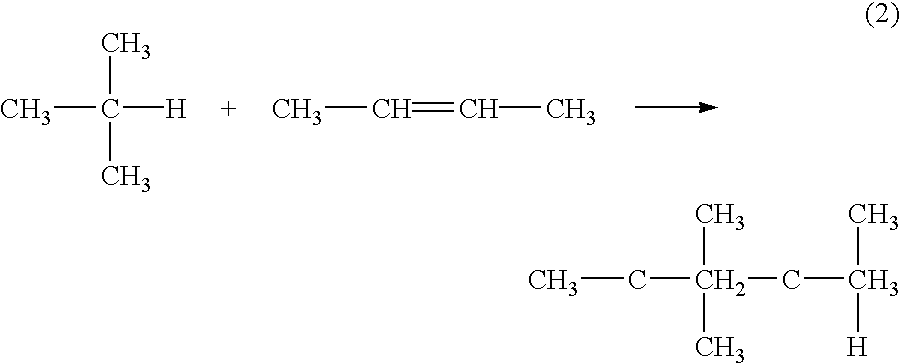Method for reactivating solid catalysts used in alkylation reactions
a solid catalyst and alkylation reaction technology, applied in the field of reactivation of solid catalysts used in alkylation reactions, can solve the problems of liquid acid catalysts, hazardous materials, disposal of sludge formed during alkylation, etc., to reduce or eliminate the need for oxidative regeneration of catalysts, maintain catalyst activity for longer periods of time, and reduce the frequency of catalyst replacement and the accompanying cost
- Summary
- Abstract
- Description
- Claims
- Application Information
AI Technical Summary
Benefits of technology
Problems solved by technology
Method used
Image
Examples
example 1
The experiments performed with flows and reaction conditions within the ranges given in this set of examples were performed with a two-column swing system such as the system schematically shown in FIGS. 1A and 1B.
Reactor 1 was fed with a mixture of isobutane and trans-2-butene in a molar ratio that ranged from 1:1 to 100:1 referring to the isobutane:olefin molar ratio. Alkylation temperatures ranged from about 5.degree. C. to about 90.degree. C., and pressures ranging from ambient pressure to about 2100 psig. The olefin weight-hour-space velocity (OWHSV) was in the range from about 0.05 to 10 (g olefin) (g catalyst).sup.-1 h.sup.-1.
Isobutane or other reactivating agents were fed to reactor 2 to reactivate the alkylation catalyst contained therein. Temperature in reactor 2 ranged from about 130.degree. C. to about 250.degree. C., and the pressure in the same reactor ranged from about 500 psig to about 4000 psig. Pressure and temperature were combined so that the isobutane or other re...
example 2
Experiments were conducted in a plug-flow reactor system using 1 gram of catalyst packed into a stainless steel tubular reactor. The catalyst utilized for the experiments was a USY Zeolite catalyst. The isoparaffin to olefin ratio was 20:1 on a molar basis, while the olefin weight-hour-space velocity (OWHSV) was set at 0.2 g trans-2-butene (g catalyst).sup.-1 h.sup.-1. Reaction conditions were 60.degree. C. and 1600 psig, set so that the reaction occurred in the liquid phase. The reactivation was done using 99.5% isobutane (or other.control reactivating agents), at various throughputs. The reactivation temperatures were varied from 130 to 210.degree. C. and the pressures from 1000 to 3180 psig. Reactivation time (at conditions) was varied from 0.5 to 3 hours.
The run and reactivation procedures were as follows: The system was started initially with isobutane, at 60.degree. C. and 1600 psig, throughout. At time zero, flow of reaction mixture (isobutane and trans-2-butene, as described...
example 3
A series of experiments were performed to determine the effect of reactivation conditions on activity recovery with isobutane for a completely deactivated catalyst under near-critical to supercritical conditions, since it was shown that there is no significant reactivation of completely deactivated catalyst in the liquid phase. Variables included reactivation temperature, pressure, time, and isobutane throughput. In addition, experiments using the temperature, time, and isobutane throughput values and varied pressure to obtain a constant isobutane density were performed. Reaction conditions were as in Example Set 2, at an OWHSV of 0.2 g trans-2-butene (g catalyst).sup.-1 h.sup.-1. Reactivation protocols were also as described in Example Set 2, but using isobutane always as the fluid reactivating agent. It was found that about 33 g isobutane (g catalyst).sup.-1 h.sup.-1 is a preferred isobutane throughput with a reactivation time (at reactivation temperature and pressure) of 2 hours....
PUM
| Property | Measurement | Unit |
|---|---|---|
| temperature | aaaaa | aaaaa |
| pressure | aaaaa | aaaaa |
| temperature | aaaaa | aaaaa |
Abstract
Description
Claims
Application Information
 Login to View More
Login to View More - R&D
- Intellectual Property
- Life Sciences
- Materials
- Tech Scout
- Unparalleled Data Quality
- Higher Quality Content
- 60% Fewer Hallucinations
Browse by: Latest US Patents, China's latest patents, Technical Efficacy Thesaurus, Application Domain, Technology Topic, Popular Technical Reports.
© 2025 PatSnap. All rights reserved.Legal|Privacy policy|Modern Slavery Act Transparency Statement|Sitemap|About US| Contact US: help@patsnap.com



